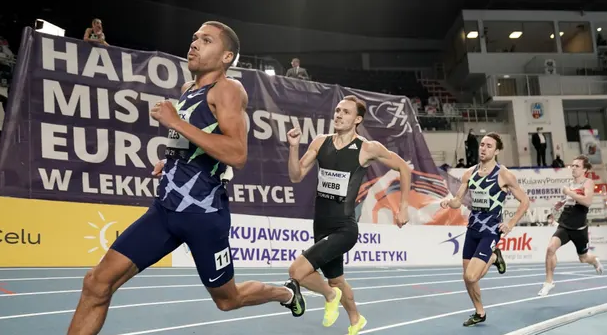- Molly O’Callaghan, a 19-year-old swimmer from Australia, etched her name in the annals of swimming history with a remarkable performance in the Women’s 200m Freestyle event
- Akshay Bhatia, 21, Wins his First PGA Tour Title at the Barracuda Championship
- Bruno Fernandes Replaces Harry Maguire as New Man Utd Captain
- Lionel Messi Surprises Teammate in group chat ahead of Grand Unveiling
- Man Utd Sign Keeper Andre Onana from Inter
Super spikes are causing a seismic shift – so why won’t athletes admit it?
- Updated: February 22, 2021
- 588

Records are being smashed but the runners involved are reluctant to admit the difference the new technology is making. Then the double Olympic 1500m medallist Nick Willis first tried athletics’ super spikes last month, they didn’t feel wildly different. A bit more cushioned, sure, which reduced the rigid impact of hitting the hard track. But then he checked his watch. It showed he had run a lung‑busting 1200m time trial two seconds faster than he expected. “I was really surprised,” he told me. “It made me a believer.”
Willis reckons the new spike technology, which is powered by a superlight and highly responsive Pebax material, is worth between one to three seconds a mile, depending whether or not someone is a “high responder”. Another Olympian I spoke to, who wanted to remain anonymous, put the advantage at two to four seconds. Either way, it amounts to a change as seismic as when cinder tracks became synthetic.
The genie is not only out of the bottle, it is granting wishes at a record rate. The men’s 5,000m and 10,000m world records? Both toppled in recent months, along with the women’s 5,000m. And then last week came the jaw-dropping sight of Elliot Giles, who has never reached a world final, running the second-fastest indoor 800m in history – 1min 43:63sec – to smash Seb Coe’s UK record.
And yet, as Willis pointed out to me, something rather curious is also happening. Not a single sponsored athlete appears to want to thank the spikes for their improved times. Giles, for instance, insisted his Air Zoom Victory spikes – which Nike claims offer a “paradigm shift” – were not a key factor in his run. “Because I’ve done well, people say it must be the shoes,” said Giles, who said he had been wearing them for a couple of years. “It’s a nonsense and a bit of an insult.”
Another Briton, Marc Scott, attributed beating his 10,000m PB by 46 seconds – which moved him above Dave Bedford and Brendan Foster in the all-time list – to “training hard and smart for years”. When the TV commentator Tim Hutchings suggested the spikes were also a factor, Scott told him to “give some credit where it’s due rather than consistently nag about the shoe technology”.Advertisement
It all amounts to a curious omerta – a case of “don’t mention the spikes” – from Nike and New Balance athletes who have benefited most from the technology. “Normally you’re asked by your sponsor to give a sales pitch, and it often seems so fake and contrived,” says Willis. “And here’s your one opportunity to really preach about it. Yet they don’t.”
Willis, who works for the high-end running brand Tracksmith, knows why athletes are staying silent. “It takes away the credit for your own role and improved performance,” he says.
Giles and Scott are far from alone in not confronting the new reality. Coe, the World Athletics president, has also played down the shoes’ impact. But as one prominent voice put it to me: “Without the shoe brands, particularly Nike, global elite athletics is dead in the water. So where’s the incentive to police it?”
So how should we react when the record books are not only being rewritten but torched in the track and field equivalent of Year Zero?
The first step, says Geoff Burns, a biomechanics expert and leading voice on shoe technology, is to “forget everything” we know about what constitutes a fast time. “In athletics, times and performances are our currency,” he says. “But some shoe companies have printed a bunch more money, and we have just had inflation. So we have to stop getting excited about fast times – because everything has changed.”
Burns also believes it is too early to say how much the new spikes improve performance – and he cautions that their impact may vary by event, as race speed, athlete mechanics and contact times with the track differ. However, he suggests that “something in the order of 1-1.5%” is a reasonable hypothesis. “It doesn’t sound like a lot but 1% is enormous at elite levels,” he says. “That’s 15m metres over 1500m. How many races are decided by much less than that?”
Burns also notes that some athletes will be high responders to the spikes, while others will see only a small improvement. And that it is entirely possible that spikes may teleport a semi-final calibre athlete to the medal podium.Russian officials banned after plan to hide doping with invented car accident
Either way, it is entirely wrong for Giles and Scott to dismiss the impact of technology – doubly so, given historical times and records are deeply embedded into the soul of track and field. And this could be just the start of an ongoing revolution. Willis, for one, expects the extra cushioning on the new spikes could allow athletes to soak up more hard interval sessions, leading to quicker times.
The one small crumb of comfort is that the delay to the Tokyo Olympics has given other companies time to catch up. “People definitely didn’t realise that one or two brands had a lead,” says Willis. “At the world championships in 2019 the spikes probably did play a major role. But the other companies will be competitive come Tokyo.”
Willis, incidentally, is yet to decide which brand he will wear at the Games, but promises he won’t necessarily pick whichever one is fastest, adding: “I don’t want to give free advertising to any company I don’t think has the right ethics.”
However, he will be wearing the new spikes. “It’s hard to go back once you have experienced the new technology,” he concedes. After all we have seen, can you blame him?


















